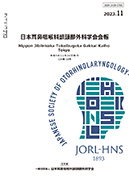Volume 126, Issue 11
Displaying 1-15 of 15 articles from this issue
- |<
- <
- 1
- >
- >|
Review article
-
Article type: review-article
2023 Volume 126 Issue 11 Pages 1185-1190
Published: November 20, 2023
Released on J-STAGE: December 02, 2023
Download PDF (594K) -
Article type: review-article
2023 Volume 126 Issue 11 Pages 1191-1194
Published: November 20, 2023
Released on J-STAGE: December 02, 2023
Download PDF (566K) -
Article type: review-article
2023 Volume 126 Issue 11 Pages 1195-1204
Published: November 20, 2023
Released on J-STAGE: December 02, 2023
Download PDF (1067K) -
Article type: review-article
2023 Volume 126 Issue 11 Pages 1205-1210
Published: November 20, 2023
Released on J-STAGE: December 02, 2023
Download PDF (953K)
Original article
-
Article type: Original Article
2023 Volume 126 Issue 11 Pages 1211-1216
Published: November 20, 2023
Released on J-STAGE: December 02, 2023
Download PDF (487K) -
Article type: Original Article
2023 Volume 126 Issue 11 Pages 1217-1223
Published: November 20, 2023
Released on J-STAGE: December 02, 2023
Download PDF (1114K) -
Article type: case-report
2023 Volume 126 Issue 11 Pages 1224-1228
Published: November 20, 2023
Released on J-STAGE: December 02, 2023
Download PDF (3826K) -
Article type: brief-report
2023 Volume 126 Issue 11 Pages 1229-1234
Published: November 20, 2023
Released on J-STAGE: December 02, 2023
Download PDF (609K)
Final Lecture
-
2023 Volume 126 Issue 11 Pages 1235-1240
Published: November 20, 2023
Released on J-STAGE: December 02, 2023
Download PDF (1733K)
Training lecture
-
2023 Volume 126 Issue 11 Pages 1242-1244
Published: November 20, 2023
Released on J-STAGE: December 02, 2023
Download PDF (553K)
Skill up lecture
-
2023 Volume 126 Issue 11 Pages 1245-1247
Published: November 20, 2023
Released on J-STAGE: December 02, 2023
Download PDF (329K)
-
2023 Volume 126 Issue 11 Pages 1248
Published: November 20, 2023
Released on J-STAGE: December 02, 2023
Download PDF (194K) -
2023 Volume 126 Issue 11 Pages 1249-1258
Published: November 20, 2023
Released on J-STAGE: December 02, 2023
Download PDF (4527K)
ANL Secondary Publication
-
2023 Volume 126 Issue 11 Pages 1261-1263
Published: November 20, 2023
Released on J-STAGE: December 02, 2023
Download PDF (192K) -
2023 Volume 126 Issue 11 Pages 1264-1266
Published: November 20, 2023
Released on J-STAGE: December 02, 2023
Download PDF (663K)
- |<
- <
- 1
- >
- >|
